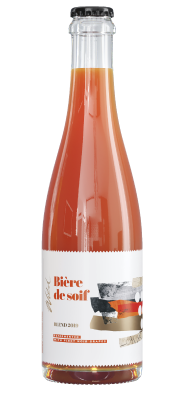We proudly present our third beer from the WILD brand – Bière de soif refermented with Pinot Noir grapes Blend 2019. It is distinguished by an interesting pink color and a complex aromatic profile rich in notes of blackcurrant, strawberries, raspberries, spices: white pepper and clove, as well as broadly understood funky notes. Beer with a very long shelf life, ideal for aging – changing over time.
Malts:
Malt base is very important for all long-aged beers and in this particular case it consists of light, simple ingredients combining Pilsen and wheat malt.
Hops:
Addition of hops is “homeopathic”, necessary from the technological point of view, because thanks to it we can clarify the wort. Bitterness is therefore trace and virtually imperceptible. Hops are the enemy of many non-yeast microorganisms, they would interfere with unhampered fermentation. Beers of this type are the least hopped beers in the world.
Fermentation:
Real magic takes place during fermentation. Each time it is unique.
Bière de soif was fermented in stages:
First fermentation: it lasted 24 days and took place in a cylindrical-conical tank with the participation of the British yeast strain Saccharomyces cerevisiae with low attenuation.
Second fermentation: lasted 8 months and took place in 300 – liter, rinsed oak barrels after port wine with a mixture of wild Brettanomyces yeast and lactic acid bacteria.
Refermentation with grapes: at the last stage of the beer production we added freshly squeezed grapes with the must of the Pinot Noir variety from the local, Lower Silesian Adoria vineyard and subjected them to a naturally-supported fermentation with the microorganizms naturally occuring on grapes.
Bottle fermentation: with Saccharomyces Bayanus champagne yeast.
Grapes:
What we added to a beer were freshly picked and crushed grapes from the local Adoria vineyard. The extractive must formed in this way made the beer slighty more concentrated. The result is an unusual marriage of wild, sour beer with natural wine of the Pinot Noir variety, whose fruits are characterized by aromas of blackcurrant, strawberries, raspberries, spices: white pepper and clove, as well as broadly understood funky.
Changes over time:
Time is extremely important for these kind of beers, because the microorganisms that take part in their production ferment slowly. That is why we leave them in barrels for several months so that they take on their extraordinary character. But this is not the end!
This beer remains alive – it is not pasteurized, but refermented in a bottle. This means that even after filling, microbes ferment – saturating, protecting and changing beer character all the time. Kept in cellar temperatures, it can be aged for years, changing its flavor and aromatic profile. Who knows what it will look like in a few years?
We are curious ourselves!
Transparent bottles:
We poured Biere de soif into transparent “Champenoise” thick glass bottles with a capacity of 375 ml, which are used in the production of champagne. This choice was not accidental – bottles of this type best match the Bierre De Soif style, emphasizing their champagne character! Under normal conditions, beers should not be stored in transparent or green glass packaging, cause they let in too much UV light, which damages hop compounds. This beer, however, is hopped to a minimal extent, and the addition of grape must naturally protect it from the effects of UV light. Thanks to this fact, we can enjoy beautiful color visible from a distance, as well as the natural opalescent effect created, among others, by bacteria and yeast that were used during fermentation.
Serving tips:
Beers of this type are highly saturated, therefore they should be served in the right way:
1. Serve well chilled
Like sparkling wines and champagne, our Biere de soif beers taste best when cooled properly before opening – we recommend storing them vertically at 4 to 6 degrees for about 24 hours before opening!
2. Be careful
The pressure inside the bottle caused by refermantation is definitely higher than in beers not subjected to this process and can be comparable to champagne – so be careful when opening!
3. Hold and pour at an angle
Holding the bottle at an angle when opening increases the surface of the liquid in the neck of the bottle, thanks to which the pressure releases more freely minimizing foaming. Transfer to glass should also be at an angle to reduce the loss of dissolved carbon dioxide and prevent excessive foaming. Beer should be poured without any natural yeast precipitate that can accumulate at the bottom of the bottle.
- Style: Bière de soif refermented with Pinot Noir Grapes
- Parameters:
- Extract: 15,0 %
- Alcohol: 8,0 %
- IBU: 5
- Ingredients:
- Malts: barley: Pils, wheat
- Hops: aromatic: Tettnanger (DE)
- Yeasts:
- Primery fermentation: saccharomyces cerevisiae (british strain);
- Barrel fermentation: brettanomyces + lactobacillus house strains;
- Refermentation with Pinot Noir grapes: microorganisms naturally occuring on grapes; brettanomyces + lactobacillus house strains
- Additives: freshly squeezed grapes with must of the Pinot Noir variety, from a local Lower Silesian vineyard
- Appearance: pink, hazy, with natural sediment
- Aromas: rich, changing over time – both in the bottle since the bottling and during the tasting (heating, oxidation): blackcurrant, strawberries, raspberries, spices: white pepper and clove, stable, tannery leather, horse rug, slightly sour (citrus, sour raspberry), wood
- Mouthfeel:
- 1 – medium high, towards high saturation
- 2 – acidic, low body
- 3 – dry with a hint of dark grape skins, with a tannin wooden finish
- Serving temperature: 5-7⁰C
- Glass: Tulip, Snifter, Stange or Flute (choose which ones you like best – Tulip and Snifter will intensify the aromatic sensations, while stange or flute will reduce them a bit)
- Foodpairing:
- Dishes: grilled goat, vegetarian stew with oyster mushrooms and smoked potato
- Cheese: feta cheese, goat salty white cheese
- Dessert: red fruit coated with dark chocolate



